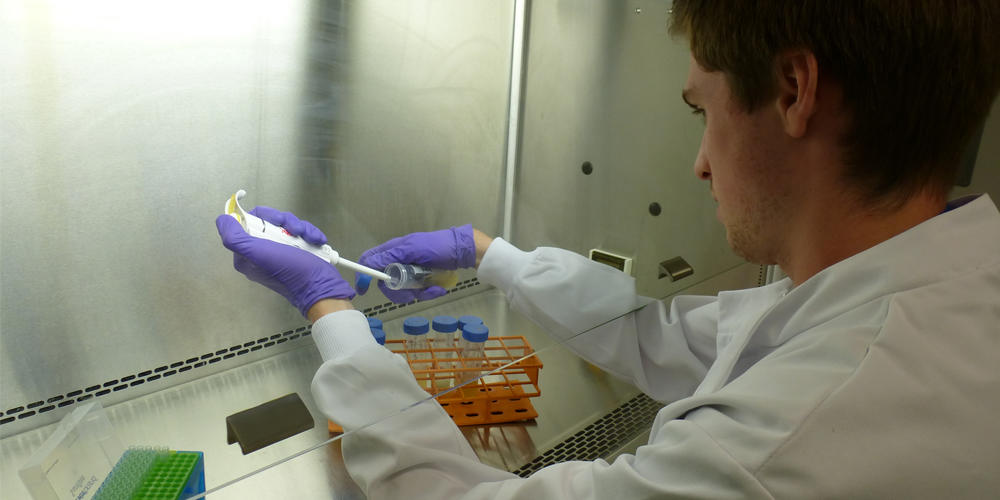Tackling antibiotic resistance the CRISPR way

The Microbiology Society is undertaking a project entitled A Sustainable Future as part of our 75th Anniversary, which aims to highlight the Sustainable Development Goals (SDGs) to our members and empower them to use their research to evidence and impact the goals. Earlier this year, we put a call out to our members to submit case studies in the following three areas: antimicrobial resistance, soil health and the circular economy.
This case study is written by David Walker-Sünderhauf, who is a PhD student at the University of Exeter and a member of the Microbiology Society. It focuses on antimicrobial resistance; a naturally occurring process, whereby micro-organisms (bacteria, viruses, fungi and parasites) can change and adapt over time, either by modifying the target of the antimicrobial, or by developing and exchanging resistance genes.
What are the challenges/needs that this research/initiative addresses?
Antimicrobial resistance (AMR) has been identified as one of the key issues facing the world in the coming decades, with deaths as a result of AMR infections estimated to surpass cancer deaths by 2050 (O’Neill, 2016). One particularly worrying aspect about AMR is the ability of bacteria to pass on genes to one another by a process called horizontal gene transfer (HGT). Through HGT, antibiotic resistance genes from harmless environmental bacteria can find their way into more dangerous human pathogens by hitch-hiking on genetic elements such as plasmids, and ultimately lead to infections that cannot be treated with routine drugs.
In recent years, biotechnology CRISPR-Cas9 has gained attention for a multitude of applications. In nature, CRISPR-Cas9 is an adaptive immune system that bacteria use for protection from invasive genetic elements such as viruses, or sometimes even plasmids. In its streamlined biotech form, Cas9 is an enzyme that cuts DNA and is applied together with a guide RNA (sgRNA) that accurately guides it to virtually any target sequence of choice.
It is not a big jump to suggest that we could co-opt this biotechnology to target AMR genes. Our approach (at the van Houte and Gaze labs at the University of Exeter in Penryn) is to target antibiotic resistance genes that are found on plasmids. These mobile genes, for instance providing resistance against β-lactam or aminoglycoside antibiotics, are often shared between diverse bacterial species and can be a contributor to cross-resistance, the phenomenon by which superbugs arise that cannot be treated by multiple classes of antibiotics.
The premises are straightforward: we programme Cas9 to target an antibiotic resistance gene found on a plasmid. The guide-RNA-enzyme system will cleave the DNA at its appropriate sequence. This stops plasmid replication and leads to removal of the plasmid and its AMR gene from the bacterial cell and its progeny, re-sensitising the bacteria to antibiotics. This approach is not new (previous studies are summarised in (Pursey et al., 2018)), but one outstanding issue in this research of AMR plasmid removal is: how do we effectively introduce the genes coding for Cas9 and sgRNA into the bacteria which need to be re-sensitised?

What findings and solutions were provided by this research/initiative?
As proof-of-concept, we constructed a donor Escherichia coli strain carrying engineered plasmid pKJK5::Cas. pKJK5 is a broad host-range conjugative plasmid with the ability to transfer itself (and all genes encoded on it) into other bacterial species – we added the gene for the nuclease Cas9 and sgRNA. In this experiment, pKJK5::Cas’s sgRNA was targeted towards a Gentamicin resistance gene. E. coli DH5α carrying pKJK5::Cas was mixed with a different, unrelated E. coli strain K12, carrying Gentamicin resistance plasmid pHERD30T.
In this way, we could remove the Gentamicin-resistance conferring plasmid from the target E. coli strain: Depending on experimental conditions, application of E. coli DH5α + pKJK5::Cas decreased the proportion of Gentamicin-resistant target E. coli K12 by 33% – more than 99% compared to a non-targeting control (preliminary findings reported at a MBS conference; (Sünderhauf et al., 2019)).
This is a promising first step and shows us that, in theory, pKJK5::Cas can be used to remove antibiotic resistance genes by applying a specialised donor bacterial strain, but further work is still needed. We are currently optimising this treatment to work in a diverse bacterial community, and to remove a resistance gene that may be shared between multiple species.
What is the future for research and innovation in this area?
In future, applications such as this could be used in environments that are hotspots of antibiotic resistance gene transfer, such as waste-water treatment plants or livestock farms. This has the potential to reduce transfer of resistance genes into human pathogens in the first place.
A CRISPR treatment to remove AMR genes is by no means a silver bullet to end the antibiotic resistance crisis – development of new antibiotics, responsible stewardship, and other research avenues are still essential. In itself, a CRISPR treatment comes with a number of challenges before it may be used in real-world applications (also summarised in (Pursey et al., 2018)). On the bright side, our experiments do highlight how such innovative technologies may pan out to be one part of the solution to keep our antibiotics working, and stop people dying from infections by bacteria that are resistant to these routine drugs.
References
O’Neill, J. (2016) Tackling Drug-Resistant Infections Globally: Final Report and Recommendations. doi: 10.1016/j.jpha.2015.11.005.
Pursey, E. et al. (2018) ‘CRISPR-Cas antimicrobials: Challenges and future prospects’, PLOS Pathogens. Edited by D. A. Hogan, 14(6), p. e1006990. doi: 10.1371/journal.ppat.1006990.
Sünderhauf, D. et al. (2019) ‘AMR gene removal by conjugative delivery of CRISPR-Cas9’, Access Microbiology. Microbiology Society, 1(1A), p. 213. doi: 10.1099/acmi.ac2019.po0082.
About the author
David Walker-Sünderhauf is a PhD student at the University of Exeter and a member of the Microbiology Society. More information about his work is available here.


